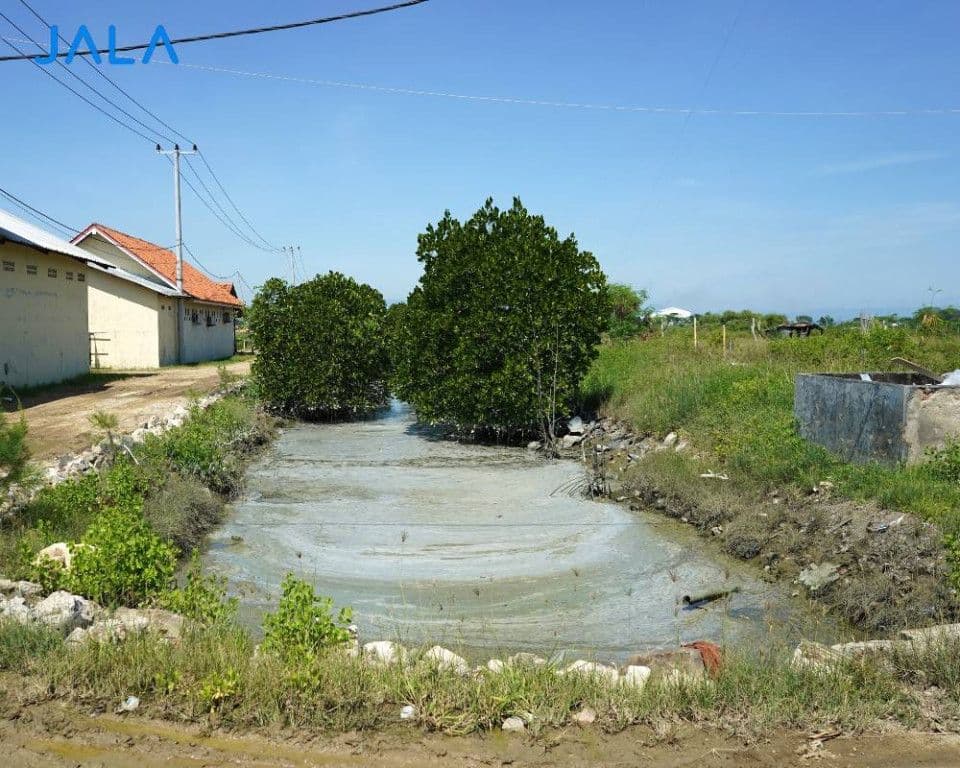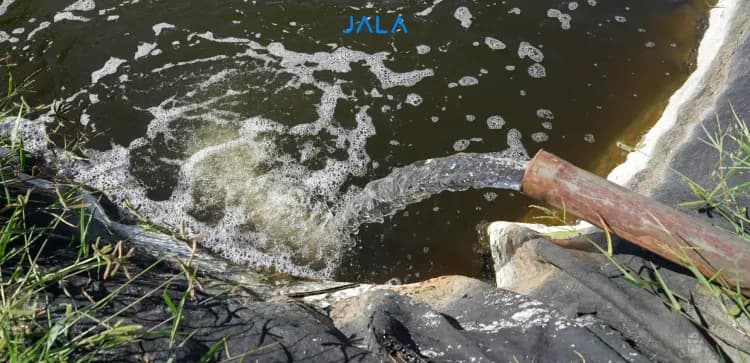
Increased shrimp production is closely related to increased stocking density, high-protein feed, and the use of chemicals. However, the expected increase in production yield is proportional to the high use of feed and the increase in organic waste and toxic compounds that have the potential to pollute the aquatic environment. The largest source of waste produced by shrimp farming comes from inedible feed residues, feces, and dead plankton organisms being the main contributors to pond sediment formation.
Not all of the administered feed is eaten by shrimp. About 17% of the feed eaten by shrimp is retained in the body, 20% is converted to feces, 48% is converted to energy, and the remaining 15% is inedible or wasted in the cultivation medium. Shrimp feed contains 30-40% of crude protein, but only about 20-25% is utilized by shrimp, while the rest is released in the form of ammonium and organic nitrogen. Only 21-24% of the nitrogen and phosphorus content in feed is used, and 10-13% is converted to waste. Waste in the form of nitrogen compounds (ammonia, nitrite and nitrate) formed from the decomposition process of organic matter in high concentrations is highly toxic to aquatic organisms.
Shrimp farming requires a lot of water as a life-sustaining medium, but inadequate waste management may deplete source water quality. Farmers need to treat shrimp farming wastewater before it is disposed to the environment. Aquaculture wastewater treatment can be done in various ways, including the addition of beneficial microbes to help improve pond water quality, the use of biofilter systems, recirculation, biofloc technology, bioremediation, or a combination of several of these methods.
Unfortunately, this technology has not been widely used, especially by medium and small-scale farmers. This is because the technology requires special energy and expertise, and requires a lot of investment capital. Based on this, easy, cheap, and effective technology is needed in handling shrimp aquaculture wastewater. Here are some simple ways that can be done to process cultivation waste to be safe before being disposed of to the environment and also have the opportunity to get additional income.
Utilization of Shrimp Pond Waste for Blood Clam
Blood clams are a filter-feeder organism that takes food by filtering suspended substances in water. The habitat of blood clams is an area with a muddy substrate, where they play the role of suspended and deposit particle feeders. Blood clams have high survival and can be used to overcome pollution of the aquatic environment due to abundant amounts of suspended solids. Thus, blood clams can potentially be used for shrimp pond waste treatment. They can effectively process waste in the form of nitrogenous nitrogen, phosphorus, and microalgae compounds from the aquaculture water of vannamei shrimp.
Utilization of shrimp farming wastewater as a medium for blood clam cultivation can be done by several methods as follows:
Co-culture Method (Polyculture)
Blood clams can be co-cultured with vannamei shrimp (farmed together, also called polyculture) in vannamei shrimp production ponds. Co-culture cultivation utilizes waste from nutrient-rich shrimp activity in sediments from shrimp’s feeding behavior and will not harm the farmed shrimp. The waste produced by shrimp can be directly utilized by blood clams.
Aquaculture waste contains nitrogen and phosphate compounds that are beneficial for the growth of microalgae, which are a source of feed for blood clams. The higher the content of organic compounds in aquaculture waste, the more abundant the presence of microalgae will be. Blood shells are a non-selective filter feeder, so that they will absorb all the suspended solids of microalgae in their bodies.
Blood clams will filter, digest, and assimilate the water particles of the cultivated pond, thus being able to remove most of the phytoplankton and other organic matter such as uneaten feed, shrimp feces, and dead plankton from the bottom of the pond which causes a reduction in chlorophyll a, nitrogenous organic compounds, phosphorus and water turbidity. This co-culture method has the potential to reduce nutrient load and improve water quality in ponds, so that waste discharged from shrimp ponds contains less nutrient compounds.
Cultivation in wastewater treatment plant ponds
Each pond is required to have a special pond as a wastewater treatment plant before being discharged into public waters. Wastewater treatment plant ponds consist of sedimentation ponds, aeration ponds and settling ponds (final-stage water storage ponds). Deposition ponds are ponds used to maintain biota that aim to reduce nutrients from waste before wastewater is discharged into public waters. This pond can be used as a container for blood clam cultivation to reduce the impact of waste while increasing the production of blood clams.
Blood clam farm (land-based farming)
The cultivation of blood clams in a separate pond is able to control the quality of the environment according to the needs of blood clams. In addition, the cultivation of blood clams in individual ponds can be maintained with high density, making cultivated blood clams protected from predators, and facilitating the harvesting process.
Shrimp pond waste can be used as a medium for shrimp and clam cultivation through the co-culture method, cultivation in wastewater treatment plant ponds and cultivation in separate blood clam ponds using shrimp pond wastewater. The use of shrimp pond waste for blood clam cultivation is able to minimize the impact of waste on the environment and increase the productivity of blood clams.
Reference
Hidayati, P. A., Mubarak, A. S. and Sudarno. The optimal n/p ratio of shrimp culture waste liquid fertilizer on growth of Chlorella vulgaris. 2nd International Conference on Fisheries and Marine Science. 1-7.
Nicholausa, R., Lukwambea, B., Zhaoa, L., Yanga, W., Zhua, J., and Zhenga, Z. (2019). Bioturbation of Blood Clam Tegillarca granosa on Benthic Nutrient Fluxes and Microbial Community in An Aquaculture Wastewater Treatment System. International Biodeterioration & Biodegradation. 142: 73-82.
Paena, M., Syamsuddin, R., Rani, C., dan Tandipayuk, H. 2020. Estimasi Beban Limbah Organik dari Tambak Udang Super Intensif yang Terbuang di Perairan Teluk Labuange. J. Ilmu dan Teknologi Kelautan Tropis. 12(2): 507-516.
Prasetiyono, E., Nirmala, K., Supriyono, E., Sukenda dan Hastuti, Y. P. 2023. Potensi Pemanfaatan Limbah Tambak Udang Vaname (Litopenaeus vannamei) untuk Budidaya Kerang Darah (Anadara granosa, Linneus 1758). Jurnal Ilmu Lingkungan. 2 (1): 420-430.
Pratiwi, R. K. dan Arfiati, D. Upaya Penurunan Bahan Organik Air Sisa Budidaya Udang Vaname (Litopenaeus vannamei) dengan Konsorsium Bakteri dan Kepadatan Chlorella sp. yang Berbeda. Jurnal pengabdian perikanan indonesia. 1 (3): 188-195.
Wittayanupakom, S., Musig, W., and Musig, Y. 2013. Filter Feeding by blood Cockle, Anadara granosa, for Water Quality Improvement in Closed Culture System of Pacific White Shrimp (Litopenaeus vanamei). Kasetsart University Fisheries Research Bulletin. 37(3): 1-12.
Short Biography of the Author
The author, Nur Setya Wati, is an active student of Diponegoro University. During her studies, the author learned a lot about the science of nutrition and feed, parasites and diseases, water quality management, as well as reproduction and genetics of aquatic organisms. The author is interested in the field of feed and nutrition and has conducted research on the use of maggots as an alternative feed in aquaculture.





